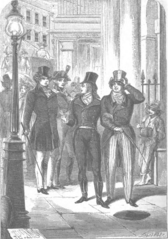“For one person to look directly at another and not acknowledge the other’s bow is such a breach of civility that only an unforgivable misdemeanor can warrant the rebuke. Nor without the gravest cause may a lady “cut” a gentleman. But there are no circumstances under which a gentleman may “cut” any woman who, even by courtesy, can be called a lady. the other hand, one must not confuse absent-mindedness, or a forgetful memory with an intentional “cut.” Anyone who is preoccupied is apt to pass others without being aware of them, and without the least want of friendly regard. Others who have bad memories forget even those by whom they were much attracted. This does not excuse the bad memory, but it explains the seeming rudeness. A “cut” is very different. It is a direct stare of blank refusal, and is not only insulting to its victim but embarrassing to every witness. Happily it is practically unknown in polite society.” -Emily Post, “The Cut Direct” in Etiquette (1922)
The ultimate Regency snub, the “cut”, was only to be employed when you were really trying to injure another party or show extreme distaste. Much the same today, ignoring someone you know would be an insult of high order and likely result in backlash.
In Regency culture, the cut consisted of four main versions.
| E. Cobham Brewer 1810–1897. Dictionary of Phrase and Fable. 1898. |
According to the The 1811 Dictionary of the Vulgar Tongue (available online by the Gutenberg Project ) To renounce acquaintance with any one is to CUT him. There are several species of the CUT. Such as the cut direct, the cut indirect, the cut sublime, the cut infernal, &c. The cut direct, is to start across the street, at the approach of the obnoxious person in order to avoid him. The cut indirect, is to look another way, and pass without appearing to observe him. The cut sublime, is to admire the top of King’s College Chapel, or the beauty of the passing clouds, till he is out of sight. The cut infernal, is to analyze the arrangement of your shoe-strings, for the same purpose.
In a later version of the dictionary by Francis Grose called DICTIONARY of Buckish Slang, University Wit AND PICKPOCKET ELOQUENCE compiled “originally by Captain Grose AND NOW CONSIDERABLY ALTERED AND ENLARGED WITH THE MODERN CHANGES AND IMPROVEMENTS BY A MEMBER OF THE WHIP CLUB ASSISTED BY Hell Fire Dick and James Gordon fisqrs of Camliridge and William Soames Esq of the Hon Society of Newman’s Hotel ” in 1811, George Cruikshanks helped co-author to acknowledge that while originally its “circulation was confined almost exclusively to the lower orders of society he was not aware at the time of its compilation that our young men of fashion would at no very distant period be as distinguished for the vulgarity of their jargon as the inhabitants of Newgate and he therefore conceived it superfluous to incorporate with his work the few examples of fashionable slang that might occur to his observation.”
I digress, but only to assure you that these dictionaries are wonderful treasures of the Regency era worth a gander to truly understand the Regency Buck.
Indeed, the cut would have largely been a manner employed by gentleman or very imperious ladies. Not a weapon for debutantes or damsels, the gesture (in its four hallowed forms) would largely have been between gentleman wanting to pick a quarrel or, already, engaged in one. For men of the regiment, the cut consisted of a figurative send down to Coventry: “To send one to Coventry a punishment inflicted by officers of the army on such of their brethren as are testy or have been guilty of improper behaviour not worthy the cognizance of a court-martial The person sent to Coventry is considered as absent no one must speak to or answer any question he asks except relative to duty under penalty of being also sent to the same place On a proper submission the penitent is recalled and welcomed by the mess as just returned from a journey to Coventry.”
Even in the modern era, the silent treatment can be particularly deadly when in a peer group, and this form of shame and ostracism (or even threat of) most likely would have brilliant at scotching offenders.
The cut, more likely the domain of men of leisure, would have been equally employed–sure to spread in the on dit riddling every Ton household.
Most famously, Beau Brummel (before his downfall in fashion) snubbed Prinny and created a scandal pictured here:

“It is well known, in all probability, that George IV. contemplated with as much disgust and horror the increasing rotundity of his ‘presence’ as ever a maiden lady of a certain age did her first grey hair. Soon after the bell affair, the royal beau met his former friend in St. James’s Street, and resolved to cut him. This was attacking Brummell with his own pet weapon, but not with success. Each antagonist was leaning on the arm of a friend. ‘Jack Lee,’ who was thus supporting the Beau, was intimate with the Prince, who, to make the cut the more marked, stopped and talked to him without taking the slightest notice of Brummell. After a time both parties moved on, and then came the moment of triumph and revenge. It was sublime! Turning round half way, so that his words could not fail to be heard by the retreating Regent, the Beau asked of his companion in his usual drawl, ‘Well, Jack, who’s your fat friend?’ The coolness, presumption, and impertinence of the question perhaps made it the best thing the Beau ever said, and from that time the Prince took care not to risk another encounter with him.” –The Wits and Beaux of Society, by Grace & Philip Wharton (1890).











Pingback: Weekend Grab Bag – From Writing Tips to a Queen Riding Darth « Angela Quarles